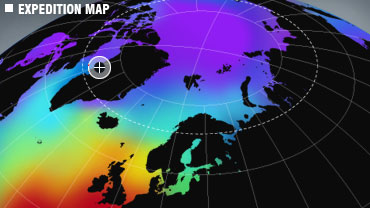The polar regions hold a profound, and even primal, fascination for so many of us. In the case of the Arctic, real journeys of adventure from Lief Erikson to Parry and Fienes, and imaginary ones from Jules Verne to Philip Pullman have added layers of meaning to its magnetic attraction, so to speak. So an invitation to go there would have been the best gift ever, even without the new and ominous message coming from the arctic. For the arctic is the harbinger of what is happening to the global climate. David Buckland, who thought up and made happen the Cape Farewell expeditions, compares it to the miner’s canaries that foretold of the presence of deadly gases underground.
If the whole world were awake to what the scientists have been telling us with increasing conviction over 30 years the Cape Farewell expeditions would hold far less interest. But it isn’t, and a combination of denial, disinformation and apathy is weakening our collective capacity to ensure that civilisation survives climate change. I have great optimism about that capacity. If we can think up and do the things that create a graph showing the atmospheric concentration of CO2 over the last 800,000 years ago, we can surely invent and implement the actions to follow a graph that will adequately reduce those concentrations over the next 50 years. The brilliant idea behind Cape Farewell is to combine the languages of science and art to communicate the message more accessibly and powerfully. I am an architect because architecture combines art, science and people, and probably share that with Peter Clegg the one previous Cape Farewell Architect who produced a lovely piece conveying the reality of the invisible gas, carbon dioxide.
The sceptics are certainly right in saying that climate change evidence is not conclusive. Yep, the UN consensus estimate looks like it might be a significant under-estimate of the rate of climate change. In 2008 arctic sea ice cover was at its second lowest level since records began. The lowest level was in 2007 when the North West passage became navigable without icebreakers for the first time in modern history. Less dramatic, but of potentially far greater harm, is the melting of the Greenland ice cap. If floating sea ice melts ocean levels do not rise; but if ice sheets slide off a landmass faster, sea levels surely rise. On board the research vessel Grigory Mikheev the Cape Farewell crew will visit Disko Bay and sail across the front of the world’s fastest glacier now moving faster than before. The glacier travels at about 1m per hour, which is comparable to the speed at which Northern Hemisphere isotherms are moving northwards. Mark Lynas explained the poleward migration of isotherms in a recent lecture in the RIBA programme “International Dialogues: Architecture and Climate Change”, pointing out that species adaptation cannot match this rate and that will lead to considerable extinction. One thing I want to try and do on the expedition is to somehow capture that glacier’s speed. I have some kit to do that but all will depend on weather and terrain.
But the main point of the expedition is to look, listen and feel. Shopping for the kit specified by the Cape Farewell team I am thrilled to hear myself telling the guys behind the counter what I need the stuff for. They are unimpressed, its hardly Everest. People are far more impressed by the names of the co-voyagers. I guess the expeditioners will quickly get used to the super celebrity of some amongst us. I am wondering whether to suggest to Jarvis a piece titled ‘arses to climate change’.
The Architects’ Journal Blog
This is the first post from Sunand Prasad, who will be be blogging about the expedition for The Architects’ Journal. Follow Sunand’s Cape Farewell diary on The Architects’ Journal website ›



